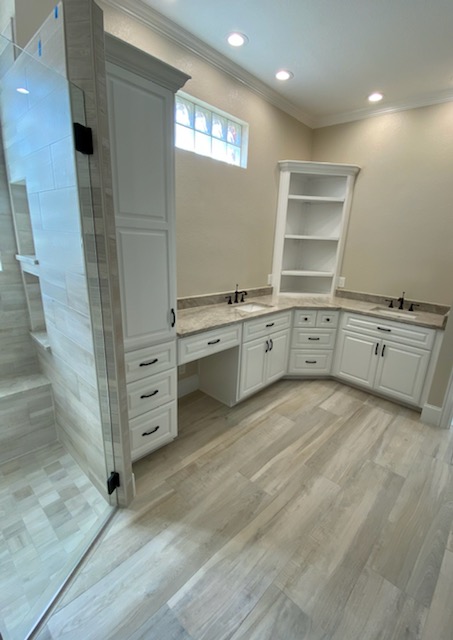4 Reasons to Start Your Home’s Remodel in Your Bathrooms
Renovating your bathroom isn’t just a cosmetic project. Ripping out the old tile and the fiberglass shower/bath combo certainly gives you a great opportunity to update the fixture into a shower with sleek stone-look tile and contemporary faucets, but that’s just the surface. It also lets you dig deep into any mold and slowly worsening construction problems below the surface. Whether you want to refinish your bathrooms or you’re just reading up on spring cleaning tips, prepare for problems hidden from sight. They include:

1. Rotting subfloors under a cracked bathtub.
If you have an inset fiberglass tub instead of a standalone ceramic one, you can get cracks without realizing it. Anything from dropping a heavy soap bottom to washing a big dog with untrimmed claws can make the fiberglass split. The resulting hairline cracks are almost impossible to see.
But they’ll still let water drip onto the floor below. If you have a pier and beam foundation, this water will start to eat through the layers of wood. Not only will you have a large patch of rot and soft wood below the tub, but the growing hole will also destabilize the rest of the floor. If you have a concrete foundation the water can pool, eat into nearby drywall, and cause mold.
2. Rodent nests behind a bathtub facade.
Water isn’t the only thing that inset bathtubs can hide. Facades also give rodents the perfect shelter. They can build their nests out of sight, near water, and against the warmth of the water pipes.
The older your bathtub is, the more likely it is that a rat or two has made a nest just out of sight. Given enough time, these pests can damage your drywall, spread disease, and eat through the wiring. Replace your bulky tub with a shower or a standalone tub with nowhere for them to hide.
3. Plumbing that isn’t up to code because of the previous owner’s DIY projects.
DIY home improvement is a growing trend. But when it comes to plumbing, it isn’t a good idea. DIY shower conversion kits and videos showing homeowners how to shift plumbing fixtures around do their best, but there’s no guarantee the job was finished correctly.
Often, improperly finished DIY projects spring leaks, develop corrosion, and don’t perform as well as professionally handled renovations. They can also make your home not be up to code. Different showers, tubs, and shower/bath combos need different diameters of drain lines, for example, which is a detail many homeowners can’t adjust for. If you try to sell or rent out your home, you could be looking at sudden expenses when you need to renovate a fixture or face penalties.
4. Soft drywall behind gaps in your shower tiles.
If you have a professional redo your shower, they’re going to use layers of water protection. That includes specialty drywall that resists moisture damage, a vapor barrier, and durable water-resistant mortar caked thick behind the tiles. The tile and the grout will also be specially chosen for long-term protection.
But there’s no guarantee that the original builders had the materials or the inclination to do as good of a job. If your showerhead is positioned to spray water at any fixed point in the tile, it might have worn away part of the mortar and grout long ago. Even if you can’t see any gaps, water will seep inside and start destroying the walls from the inside out. It can also damage the insulation if your shower is against an exterior wall. This encourages mold, mildew, and bugs to make your walls their home.
Bathrooms are some of the most important rooms to remodel in an older home, whether it’s your forever home or you want to put it on the market. Contact us at Complete Construction DFW for more tips to remodel every part of your home.
